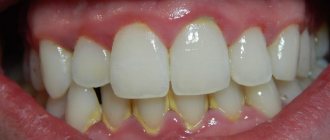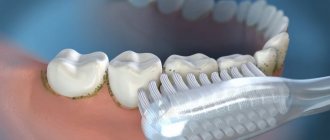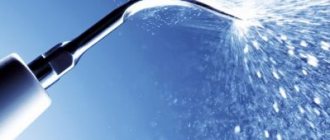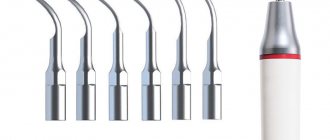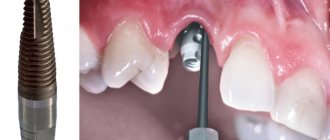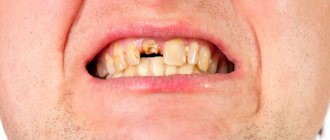A beautiful, snow-white smile attracts attention and characterizes its owner as a neat and attentive person. Untidy teeth do not decorate anyone, they only cause rejection. In order for them to always be white, beautiful and smooth, it is necessary to periodically visit the dental office, conduct an examination, and do preventive procedures.
Tartar is mainly the result of improper oral care. Food residues under the influence of bacteria turn into soft plaque. Accumulating in places hard to reach with a brush, plaque eventually turns into tartar.
The appearance of tartar should be taken seriously
Many people do not pay enough attention to such a “little thing” as tartar. This is because it does not cause any discomfort, pain and is not always noticeable to others. However, such an attitude towards the appearance of tartar can lead to detrimental consequences. Over time, this aesthetic defect can turn into a serious disease. The most common problems that arise are tooth decay or periodontal disease.
In order to get rid of tartar, you need the help of a professional. In dentistry, a specialist will be able to see even the most hidden tartar and remove them. The procedure is simple and does not take much time. The final cost of the service depends on the method of removal and the number of stones.
Types of Tartar
Tartar has its own classification - according to the field of education. Based on this feature, mineralized deposits are divided into two types:
- Subgingival calculus. Deposits accumulate under the edge of the gums, in the area of the gum pockets. A characteristic feature of subgingival tartar is its increased hardness. Mineralized subgingival deposits can cause an active inflammatory process in the periodontium (soft tissues of the oral cavity) and lead to gingivitis or periodontitis. It is impossible to remove subgingival stone at home: only a dentist can remove deposits in this area;
- Supragingival tartar forms above the gum level and is therefore clearly visible on the teeth. It can become stained from contact with food, and in smokers it has a distinct yellow or brown color. Supragingival tartar harms the healthy state of enamel, increases the risk of caries and, of course, spoils the appearance of teeth. It needs to be removed urgently, because the longer the stone is on the teeth, the denser and harder it becomes.
Symptoms such as the appearance of bad breath, discoloration of the gums, heavy plaque on the teeth after eating, and roughness of the teeth may tell you that tartar has formed on your teeth. If you observe such signs in yourself, be sure to contact the dentist for tartar removal and professional oral hygiene!
Painless
Of course, almost everyone who is faced with the need to clean stones is concerned about the issue of painlessness. There is no need to worry, because even without the introduction of an anesthetic drug, no particular discomfort will arise. This is due to the fact that the master’s work is carried out only on the surface, that is, there is no contact with deeper, sensitive tissues. If you need to carry out hygiene of gum pockets, then it is permissible to use infiltration or application freezing methods.
Ultrasonic and sandblasting are the most delicate and fastest. Both of these techniques do not cause any adverse reactions from internal organs, and there are no unpleasant sounds or smells during the procedure. If teeth and gums in everyday life react sharply to cold and hot, sour and spicy, then this indicates increased sensitivity. Such patients may experience pain even when touching the tooth with a fingertip.
It is worth understanding that if during cleansing there is no discomfort due to pain relief, then after the cessation of its effect, pain may appear. To cope with it, medication is allowed. This should be done only in accordance with the dosage specified in the specialist’s prescription. Increased sensitivity of the enamel after removing deposits is normal. As a rule, after a few days the unpleasant symptoms disappear.
Methods for removing tartar used in dentistry
Previously, only mechanical cleaning was used to remove tartar in dentistry, which involved the use of special hand tools: scalers, curettes, excavators, smoothers, chisels, rasps. The procedure was labor-intensive, long and painful for the patient, and also very traumatic.
When manually removing tartar, a fairly large layer of healthy tissue was removed from the teeth and this led to unpleasant sensitivity of the teeth and thinning of the tooth enamel. Nowadays, mechanical removal of tartar is used extremely rarely, only in cases where the patient has contraindications to other methods of cleaning teeth from deposits.
Another outdated and rarely used method of removing plaque is to clean teeth from plaque using special chemical solutions.
The teeth were treated with preparations based on alkalis or acids that dissolve mineralized deposits. However, the chemical method of removing tartar is aggressive, it carries a high risk of burns to the soft tissue of the oral cavity, it negatively affects the condition of tooth enamel, so dentists have long abandoned its use. Nowadays, two modern and highly effective methods are used to remove tartar - ultrasonic cleaning and laser cleaning. We will tell you about these technologies in detail below.
Curettage – mechanical removal of dental plaque
Curettage is a procedure during which the dentist removes dental plaque mechanically . This is necessary when plaque or stones are in a periodontal pocket that is inaccessible to ultrasound and an aerosol jet.
There are two types of curettage:
- Closed;
- Open – involves an incision in the gum.
During curettage, not only deposits on tooth enamel are removed, but also pathologically altered tissues .
Ultrasound removal of tartar
Ultrasonic tartar removal is a technology that allows you to quickly and painlessly remove mineralized plaque without damaging tooth enamel. The procedure will use a special ultrasonic device with a tip - a scaler. The generator in the device creates ultrasonic waves, which are transmitted to the scaler. The frequency of the waves can be adjusted, which gives the dentist the opportunity to choose the most effective and safe mode of operation.
When removing tartar with ultrasound, different types of tips can be used. By changing the tips, the dentist will clean the outer part of the teeth from mineralized deposits and remove plaque in the subgingival area. Effective and rapid removal of tartar is due to a double action:
- An ultrasonic wave is applied to the tip with a certain frequency, creating vibrations that destroy tartar mechanically;
- Since ultrasonic cleaning can be carried out using liquid, the simultaneous supply of water and ultrasonic waves leads to the effect of cavitation or, in simple words, the formation of a large number of microbubbles that loosen tartar and improve the process of its separation from tooth enamel.
The scalers of modern ultrasonic devices are equipped with illumination, which improves the quality of tartar removal.
AirFlow dental plaque removal device
After polishing, the doctor applies special protective compounds to the teeth, usually varnish with the addition of fluoride
AirFlow - this is a technology that can be used to remove plaque and make teeth half a tone lighter . To do this, tooth enamel is treated with a jet consisting of a liquid, an aerosol and an abrasive substance, the basis of which is sodium bicarbonate (soda). This technique is quite effective and soft, gentle on dental tissues.
Benefits of ultrasonic tartar removal
Ultrasonic tartar removal technology has the following advantages:
- It is highly effective; using ultrasound, it is possible to remove tartar from both the external surfaces of the teeth and the subgingival space;
- When removing tartar, ultrasound does not injure or damage tooth enamel;
- Ultrasound destroys pathogenic microflora in the oral cavity, and therefore removal of stone and plaque by ultrasonic cleaning is an excellent prevention of various dental diseases;
- The procedure for removing tartar using ultrasound is quick and painless for the patient.
The advantages of ultrasonic tartar removal include the affordable price of the service. Ultrasonic cleaning is universal and can be carried out as an independent hygienic procedure or in combination with Air Flow cleaning. It is imperative to remove tartar with ultrasound before dental treatment, prosthetics, implantation, or wearing braces.
Pros and cons of the procedure, possible contraindications
Despite many positive reviews about the procedure, not all people can undergo ultrasonic teeth cleaning. It is contraindicated in the following cases:
- if the patient has serious diseases of the cardiovascular system, asthma or chronic bronchitis;
- in the presence of cancer;
- for tuberculosis, AIDS or hepatitis;
- for epilepsy and diabetes;
- in case of acute respiratory diseases or inability to breathe through the nose;
- for those patients who have implants or orthopedic devices;
- for those whose enamel is too sensitive;
- children before the change of milk teeth.
- It is not recommended to carry out ultrasonic cleaning in the first half of pregnancy.
But despite this, this procedure has many advantages over mechanical and chemical teeth cleaning:
- it is more effective and removes plaque of any hardness even from hard-to-reach places;
- eliminates darkening of enamel due to smoking, food dyes or drinking coffee;
- eliminates allergic reactions and negative effects of chemicals on the body;
- does not damage the enamel and does not increase its sensitivity;
- ultrasound also removes bacteria, maintaining normal microflora in the oral cavity;
- slightly whitens and polishes teeth, restoring their natural color and shine;
- Serves as a prevention of caries and periodontitis.
But not everything is so rosy. There are also negative reviews from patients. They note that the procedure caused them pain. Indeed, this is possible if subgingival deposits are removed. But to prevent unpleasant sensations in this case, you just need to carry out cleaning under local anesthesia.
Laser tartar removal
Laser tartar removal has been used in dentistry relatively recently. This technology involves removing mineralized deposits with a directed laser beam. The procedure is quick, painless and has the following advantages:
- High security. The laser beam destroys only plaque and does not damage the enamel and soft tissues of the oral cavity;
- Laser radiation destroys pathogens and stops inflammatory processes;
- Laser tartar removal takes place without discomfort or pain.
The disadvantages of laser tartar removal include a fairly large list of contraindications and the high cost of the procedure.
Air Flow for removing tartar
Air Flow is a technology used for professional teeth cleaning. It copes well with pigmented soft plaque, helps lighten tooth enamel to its natural shade, refreshes and disinfects the oral cavity. But with so many advantages, Air Flow is ineffective in the fight against tartar.
If a large amount of hard dental deposits have accumulated in the patient’s oral cavity, to remove them, properly clean with ultrasound or laser and only then use Air Flow.
Is it possible to remove tartar at home?
On the Internet you can find countless recipes that claim to help remove tartar. Most of these recipes involve the use of caustic substances that must be applied to the surface of the teeth and, under the influence of these substances, the tartar should dissolve.
But we do not advise you to conduct such experiments on your health. Using caustic solutions will not help you remove tartar, but it will weaken and destroy tooth enamel and can lead to burns of the soft tissues of the mouth and other unpleasant consequences. In addition, no folk remedies will relieve you of subgingival tartar.
You need to remember that tartar removal should be carried out in a dental clinic, by a competent hygienist who uses safe materials and modern tools in his work! There is no need to be afraid of this procedure - it is painless, and in addition, before removing tartar, you can always apply local anesthesia, which completely removes all possible unpleasant sensations.
Air abrasive systems for cleaning tooth surfaces
Intraoral powder blasting devices can be used to remove colored deposits from the surface of teeth (smoker's plaque, food coloring), high-quality cleaning of fissures of the chewing surface, cleaning smooth surfaces of teeth before fixing braces, polishing tooth surfaces after scaling
(Air-Flow (EMS), Pro-phyflex (Kavo), Prophy-Jet Cavitron (Dentsply), ProphyEST (Geosoft Pro). Devices of this type can be produced as a separate unit connected to an alternating current network and to a compressed air network from compressor, or in the form of tips connected to the place of the turbine handpiece of the dental unit. The principle of their operation is to clean the surface with a mixture of water and sodium bicarbonate powder, driven by air compressed under high pressure (Fig. 123). , the powder can cause damage to the epithelium, so soft tissues should be isolated, and the spent mixture should be removed from the working area with a suction device (Fig. 124).The
Prophy-Jet Cavitron air polisher (Dentsply)
is equipped with a waste powder collection system (Fig. 125) It is not recommended to use powder blasting devices on areas of exposed root cement or dentin, as well as fillings made of composite materials.
Prevention of tartar formation
Is it possible to prevent tartar from forming? This question is often asked to dentists by patients after dental plaque removal procedures. Alas, there are no technologies in dentistry that would help get rid of tartar once and for all, but prevention can be carried out to promote the formation of deposits in smaller quantities and slow down the rate of their formation.
Effective prevention of tartar formation will include the following measures:
1. Regular brushing of teeth with the correct movements and the right toothbrush and toothpaste. If you don’t know which brush and paste are right for you, the dental hygienists of our clinic in Moscow, “Aesthetica”, will help you find the answer to this question!
2. When brushing your teeth, be sure to use dental floss or special brushes to help remove plaque and food debris from the spaces between your teeth.
3. Buy irrigators that help remove plaque from the subgingival space.
4. Stop smoking, drinking alcohol frequently, reduce the amount of sweet foods in your diet, and eat solid foods.
To remove tartar in a timely manner, visit the dentist once every six months and carry out professional oral hygiene procedures.
FAQ
This procedure is still new, people don't know much about it, so they have a lot of questions. Even those who have tried to have their teeth professionally cleaned once are afraid that they have caused harm to the enamel. What are patients most often interested in?
- Many people do not have professional cleanings because they believe that they are harmful to their teeth. But ultrasound does not have any mechanical effect on the enamel and does not damage it. Therefore, such cleaning is the simplest and safest.
- Patients are wondering whether the procedure will be too expensive? The price of ultrasonic cleaning depends on the quantity and quality of plaque, on how many teeth are affected by caries. Typically, this service is provided only by private clinics, but even in them it is not very expensive. The cost of professional cleaning of one tooth ranges from 100 to 150 rubles. For the complete procedure, the patient will pay from 1,500 to 3,000 rubles. But for this money you can then enjoy a snow-white smile for a long time.
- Some people are interested in the duration of the procedure. Complete ultrasonic cleaning takes about an hour. Additionally, you can do teeth whitening and polishing with an Air Flow device or polishing with special brushes. Special pastes or varnishes are applied to the teeth to reduce the sensitivity of the enamel and protect it from plaque formation.
- Many people are afraid of pain during the procedure, especially if they have sensitive enamel. In fact, most patients do not feel the effects of ultrasound at all. And only in some cases, when treating subgingival deposits or removing particularly large tartar, unpleasant sensations are possible.
- Is it possible to do ultrasonic teeth cleaning during pregnancy? This question is asked by many women. In fact, ultrasound does not harm the baby or the mother’s body. But due to a woman’s decreased immunity, bleeding gums or other complications may occur after the procedure. Therefore, it is better to resolve this issue with your doctor individually. It is not recommended to carry out the procedure in the first trimester, shortly before childbirth and in cases where the woman has never had ultrasonic cleaning before.
- Many patients who liked the procedure and how beautiful their teeth became after it are interested in how often ultrasonic cleaning can be done? Depending on the rate of plaque and tartar formation, dentists recommend doing this once every 1-2 years. But sometimes cleaning is required every six months.
In many cases, the effectiveness of the procedure depends on the professionalism of the doctor. Therefore, it is very important to choose the right clinic for oral care. And you need to pay attention not to prices, but to the qualifications of the staff. Many patients have learned from their own experience that it is cheaper to pay for preventive procedures than to later treat caries and periodontitis. And if ultrasonic cleaning is performed correctly, plaque will not form for a long time, and the patient will enjoy a snow-white smile and healthy teeth.
Comprehensive teeth cleaning: service from our dentistry in Moscow “Aesthetica”
To ensure high-quality removal of tartar, we offer our patients a comprehensive teeth cleaning service, which includes:
- Ultrasonic cleaning;
- Air Flow cleaning;
- Grinding and polishing of enamel;
- Fluoridation.
An integrated approach to teeth cleaning guarantees a high quality procedure and is an excellent prevention of caries and gum inflammation. After the cleaning procedure, our hygienists will definitely give you recommendations on proper oral hygiene to help keep your teeth beautiful and healthy.
In our clinic, modern equipment is used to carry out comprehensive teeth cleaning, and all conditions have been created for comfortable treatment and procedures. We are proud that we can offer you the best dental technologies, high-quality materials from world-famous manufacturers and, of course, our professionalism, knowledge and experience.
Dental clinic “Aesthetica” - with us your teeth will be healthy and your smile will be dazzling! Come to us: we have opened two branches for you in Moscow - in Barvikha and in Podsosensky Lane!
